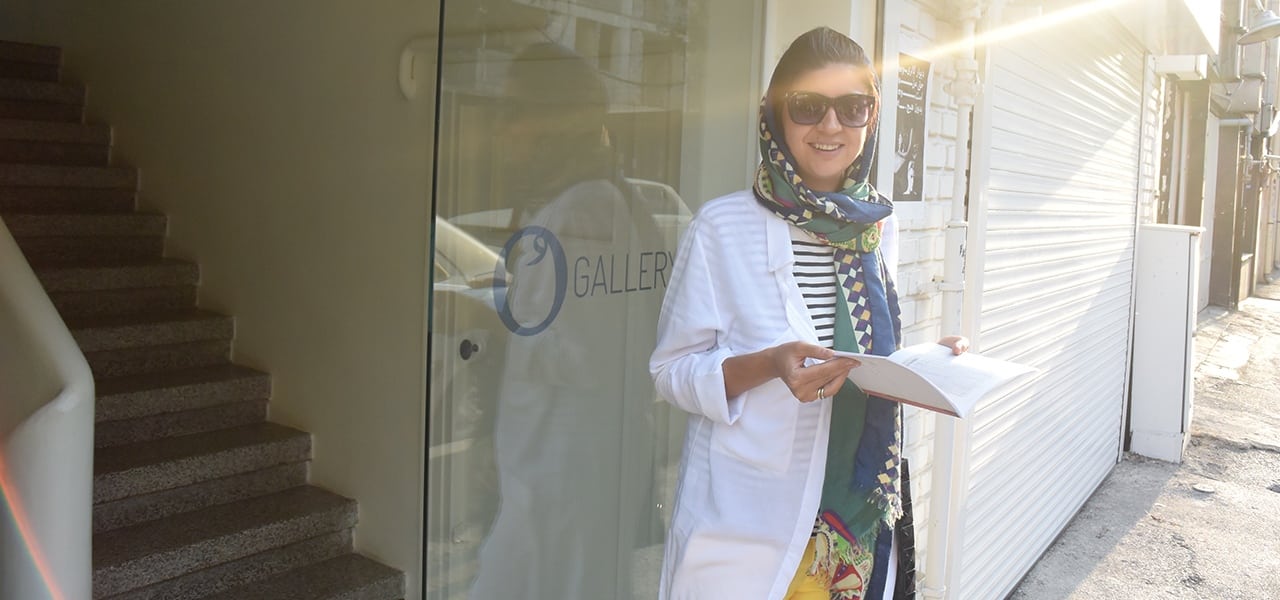
Mahsa Mergenthaler Shamsaei, portrait
In the wake of the forthcoming exhibition Selfies in the City by Iranian painter Romisa Sakaki, we had a chance to talk to Mahsa Mergenthaler-Shamsaei, founder of Young Persian Artists and curator of this show. We spoke about the exciting developments in contemporary art, her brainchild YPA, and the forthcoming exhibition. In the following conversation, Mahsa describes a new wave in Iranian art, the motivation behind her projects and details on Romisa Sakaki’s work. Enjoy the talk!
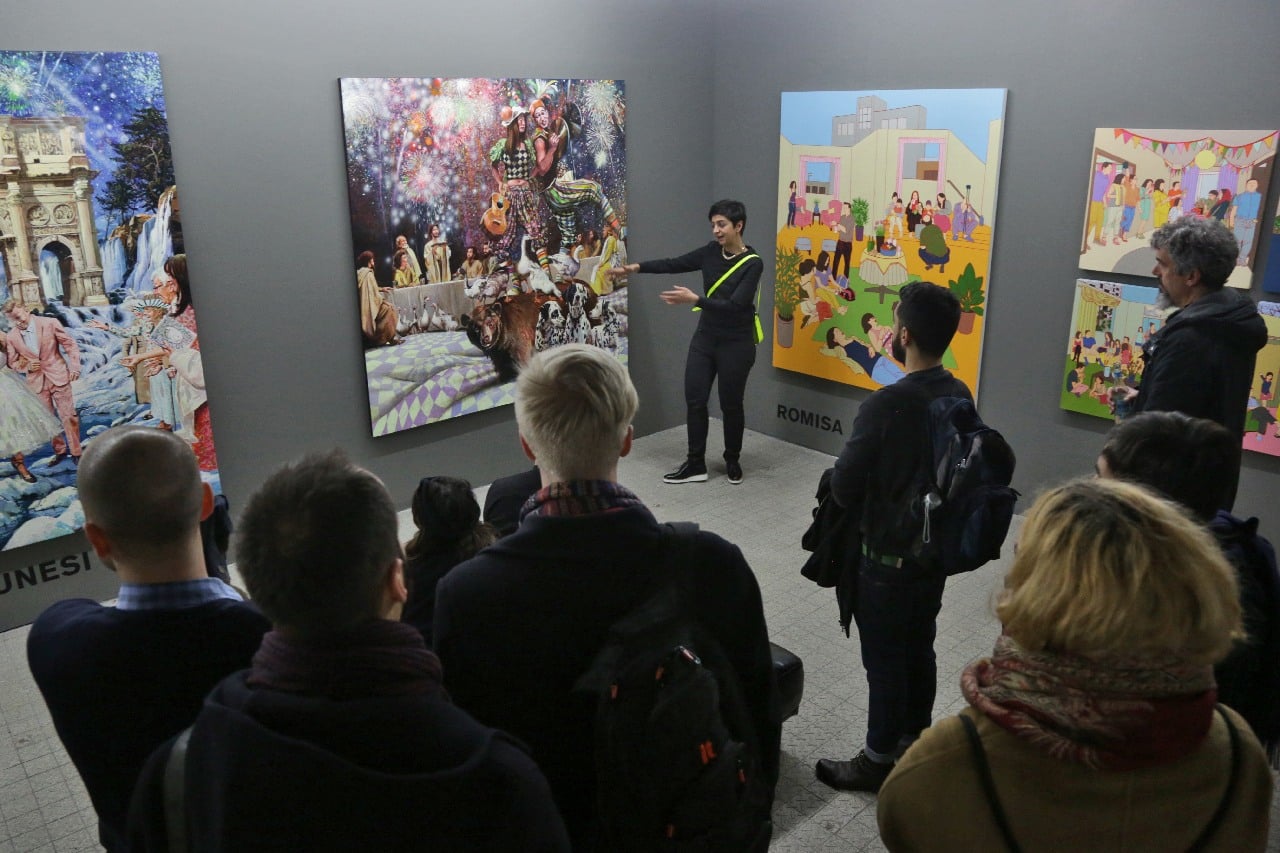
Mahsa Mergenthaler Shamsaei curating Hope Dreams Desire exhibition, courtesy of Mahsa Mergenthaler Shamsaei
Contemporary Persian Art and Its New Wave
OPEN WALLS: You initiated the Young Persian Artists (YPA) project in order to promote, showcase and illustrate a new wave in contemporary art. How would you describe this new wave in relation to contemporary art in general?
Mahsa Mergenthaler-Shamsaei: By way of background, Iran is a country of paradox, contradictions, youth and history. Over 60 percent of Iran’s 80 million people are under the age of 30. They are tech-savvy, educated and very much members of a globalised world. Often this does not sit comfortably with the realities of a country which (at least economically) has been closed off to the rest of the world for over 35 years. The manifestations of these realities result in rich, complex and very relevant art, studies of the human struggle in its most contemporary sense.
Art education in Iran still places great emphasis on the craft of making art. There is a deep respect for the basics of art making: an idea, paint, canvas and the will to make something beautiful. Aesthetics are still relevant and the artist is still very present in their work. From a style perspective, I feel that works often recall surrealism. Due to issues of cultural and legal sensitivities, artists have become incredibly talented at saying what they need to say without causing offence or getting themselves into trouble.
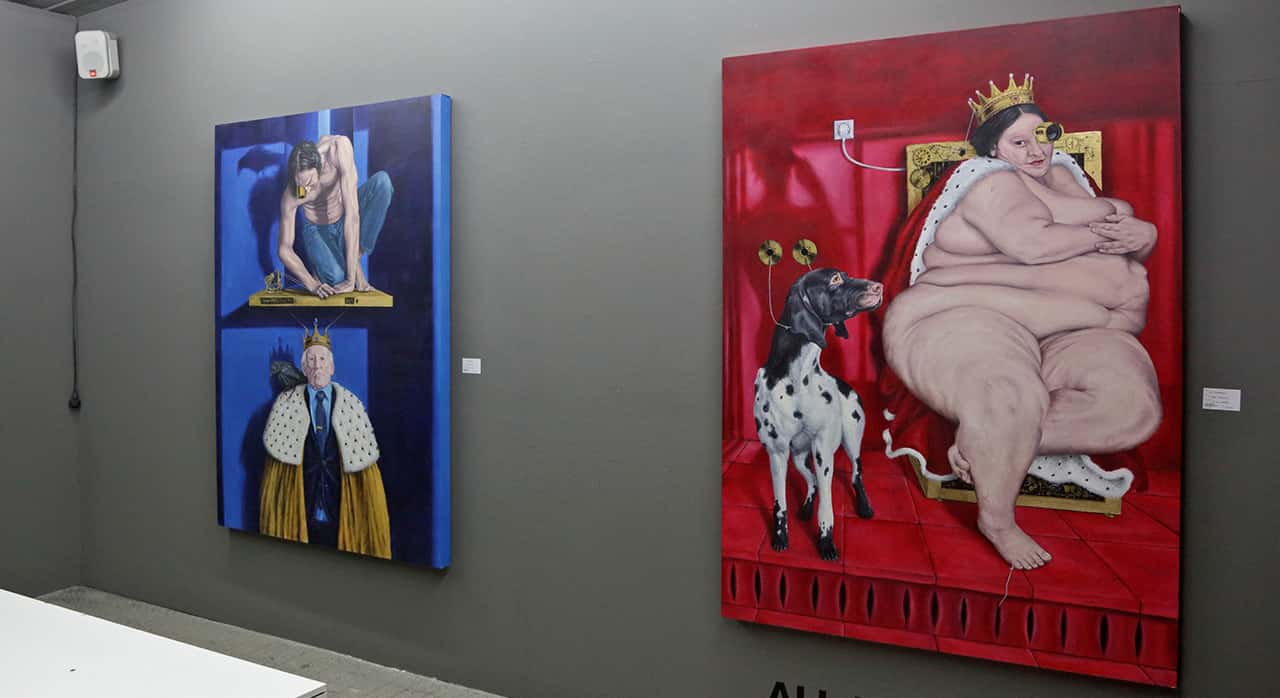
Hope Dreams Desire, installation view, courtesy of YPA – youngpersinartists.com
The Ideas behind YPA Project
OPEN WALLS: You are a shipping lawyer by profession. When you first started the YPA blog, did you think of it as a personal project, a platform where you explore your passion for art, or were you hoping from the beginning that it would grow into something greater?
Mahsa Mergenthaler-Shamsaei: A little bit of both. I have been watching the art scene in Iran flourish ever since I attended high school in Tehran in the late-90s. I went to a show at Golestan gallery in Tehran over a decade ago and saw work by one of my favorite artists Samira Alikhanzadeh. I remember feeling frustrated already then at how sad it was that the incredible art being made in Iran wasn’t being seen elsewhere. Fast forward almost two decades, when I finally set up the YPA project. In summary, I set up this non-for-profit platform in the hope that it opens doors and lets people see the great art being made in Iran today. But on a personal level, it keeps me connected to, thinking about and experiencing something I love and can’t live without.
OPEN WALLS: The YPA website is an essential reference when it comes to emerging Iranian artists. How do you find all those remarkable talents, considering you are now living and working in Europe?
Mahsa Mergenthaler-Shamsaei: Social media. Without social media this project would not exist. I of course make regular visits to Iran but essentially I do a lot of my work over Skype and see a lot of art work by trawling through Facebook late at night. Irony is that until recently Facebook was in fact censored in Iran. Didn’t seem to stop artist sharing their work though.
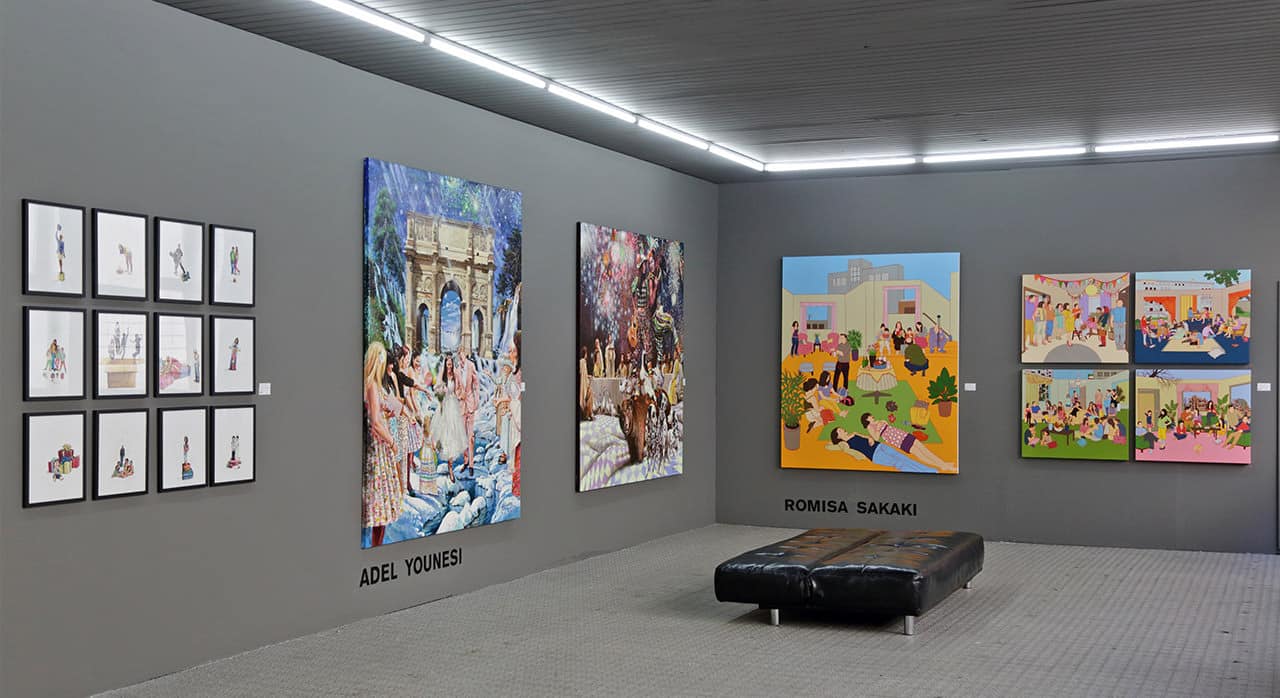
Hope Dreams Desire, installation view, courtesy of YPA – youngpersinartists.com
Who are YPAs?
OPEN WALLS: In terms of style or ideas, what are the criteria artists have to meet in order to be featured on your platform?
Mahsa Mergenthaler-Shamsaei: We have absolutely no strict criterion style or ideas. Only that the artists be young. Usually this means either being born or coming of age after the revolution in 1979.
OPEN WALLS: YPA openly references the Young British Artists movement. YBAs were often noted for their shock aesthetics, sensationalism and bold approach to social and political issues. How do you see YPAs in relation to these aspects?
Mahsa Mergenthaler-Shamsaei: The shock aesthetics or sensationalism are not really part of my thinking. It’s more the desire of young artists to move away from the status quo in Iranian art. Contemporary art in Iran is a very broad notion which encompasses artist who came of age before the revolution under very different circumstances. Whilst young artists working today also fall under the label of contemporary, they are radically different in their approach. The urgency in their work, their categorical messaging and how they often tread the line of what is socially acceptable is what leads me to the labelling YPA.
OPEN WALLS: You curated the first YPA exhibition in Berlin and you will also curate Romisa Sakaki’s solo show at OPEN WALLS Gallery in April. What are your experiences when it comes to reception of Iranian art among European viewers?
Mahsa Mergenthaler-Shamsaei: For me art is very much about humans figuring themselves and their lives out. During the show last year we had hundreds of diverse visitors from all over, but I really felt they connected with the work. My ambition for YPA has always been to run a platform which I hope opens doors and lets people see the great art being made in Iran today but also helps different people see how we share similar struggles. Often it’s a similar story for us all and time and time again I see that art is a universal language which really brings people together. It doesn’t really matter where the artist or audience come from.
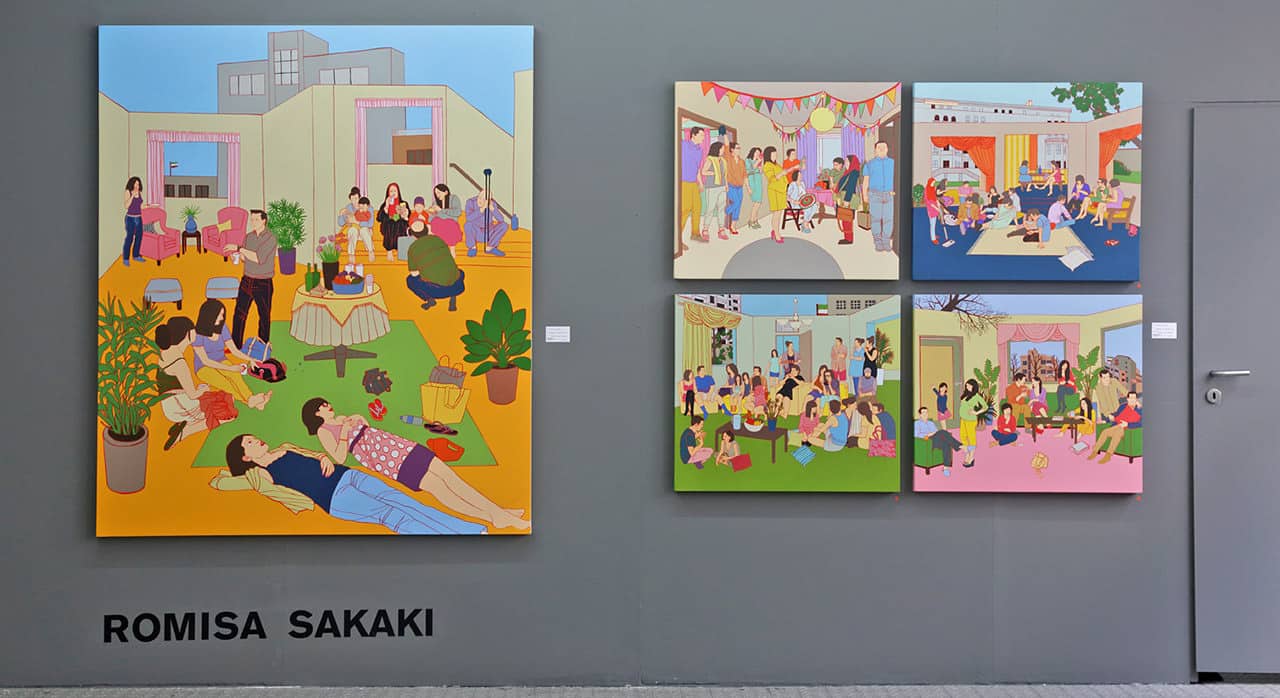
Hope Dreams Desire, installation view, courtesy of YPA – youngpersinartists.com
On Romisa Sakaki’s Solo Show and Future Plans
OPEN WALLS: What are your expectations for the forthcoming solo show by Romisa Sakaki and can you tell us something more about the exhibition?
Mahsa Mergenthaler-Shamsaei: The show is titled Selfies in the City and it covers Romisa’s work from 2009 onwards. She is a perfect example of this new wave of artist from Iran but she is also an extremely talented artist in her own right. Visitors of the show can expect to see very exciting work executed in Romisa’s unique vocabulary and style. Additionally however, viewers will also review what has happened in Iran during these past very turbulent years. Her work is very much influenced by her surroundings and her surroundings are deeply subject to political and economic turmoil and change.
OPEN WALLS: What are the plans for YPA after this show?
Mahsa Mergenthaler-Shamsaei: I have a new list of artists that I am very excited to interview, learn about and write about. So in short, I plan to continue profiling artists and building on what we have achieved so far.